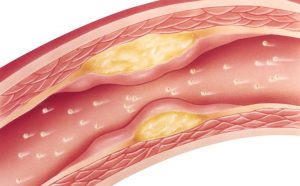Staring through shop windows when you cannot walk any further

What are shop window legs?
Claudication intermittent is caused by a disturbed circulation in the legs. This is the result of deposition of lime and fatty substances against the inner wall of the arteries. This is called plaque formation. This process causes the leg arteries to become increasingly narrow. The leg muscles then get too little blood and oxygen when exercising, such as walking, running and climbing stairs. As a result, the muscles start to acidify and a cramping pain develops in the calves. The pain will diminish within a few minutes of rest. After a walk, however, the symptoms return.
What are the four stages of shop window legs?
Physicians divide claudication intermittent in four phases. In the beginning, the leg arteries are constricted, but no typical symptoms are experienced. In the next phase you will actually suffer from shop window legs. If you can walk more than 100 meters without pain, you will be talking about stage 2A. At stage 2B this walking distance is shorter.
The next step of claudicatio intermittens is that your legs and / or feet also hurt at rest. The supply of blood and oxygen to your legs has been seriously damaged by plaque deposits. At the last stage, all alarm bells go off at the doctors’. Non-healing wounds develop and the risk of tissue death increases. As a result, there is a chance that a toe or even foot must be amputated. Phases 3 and 4 are called critical ischemia by doctors, because the blood pressure in the legs is dangerously low
What is the cause of shop window legs?
The main cause of shop window legs is therefore atherosclerosis: arterial calcification in the legs. Your lifestyle determines to a large extent whether you may be affected by this condition. People, who eat healthy, exercise a lot and do not smoke, are less likely to develop atherosclerosis. Not only in the legs, but also in other arteries that run through the body. These are the main risk factors for the development of arterial calcification:
• Smoking makes the inside of the vessel wall rougher, which makes it very easy to accumulate fatty substances.
• Saturated fat in the diet increases LDL cholesterol in the blood. This ‘bad’ fat easily accumulates against the vessel walls, making the passage increasingly narrow.
• Due to overweight, the quality of your vessel walls decreases.
• When the physical activity is low, the vessels become stiffer, so that fat can be easily deposited.
• Aging also plays a role. With increasing age, flexibility of the vessel walls gradually decreases. This increases the risk of arterial calcification.
• A lot of atherosclerosis occurs in some families. Heredity can therefore play a role.
• Certain disorders can also play a role, such as diabetes mellitus (diabetes) and high blood pressure (hypertension).
What are the symptoms of shop window legs?
The most important complaint is pain when walking. After a fixed walking distance you will experience cramp pain in your legs. This usually occurs in your calves, but can also occur – depending on the narrowing – in your thighs or glutes. Walking does not seem possible anymore. After a few minutes of rest, the pain decreases and you can continue. In severe constrictions, the walking distance is only a few dozen meters. Moreover, the pain also occurs at rest due to low blood pressure. This occurs especially at night. Due to the narrowing of the leg arteries too little blood, oxygen and nutrients are supplied to the legs. You can also notice this, among other things, with regard to cold feet, toenails, less feeling in your legs, no more hair growth on the legs and feet and too slow-growing toenails.
How are shop window legs treated?
The GP will compare the blood pressure of your arms with that of your ankles. This is called the arm-ankle index. In case of arterial constriction, the blood pressure in your ankles is considerably lower than in your arm. In the initial stages of shop window legs you can still do a lot to improve the blood circulation of your legs for example a lot of walking. This effort stimulates the blood supply to the small capillaries. In this way, after some time, alternative routes arise that guide the blood around the constrictions. This way your legs will be better supplied with blood again and the symptoms will decrease when you walk. In addition, the GP will force you urgently to stop smoking and to eat healthier with less saturated fat, because this increases the cholesterol part of plaque formation against the artery walls of the leg arteries.
Unfortunately, there are no medicines to treat shop window legs. In an advanced stage of this condition, the doctor will prescribe medication for high blood pressure, against high cholesterol or blood thinners. You must then continue to use this for the rest of your life. Sometimes the narrowed leg artery can be ‘widened’ in order to restore the blood flow. In case of very serious complaints, surgery can be carried out. Usually it is a ‘bypass’ meaning that a detour is made with a good vein of the patient or an artificial one.
Walk training reduces complaints and increases the walking distance
Walk training is the most important form of treatment for beginning at advanced shop window legs. This is best done under the supervision of a specialized remedial therapist or physiotherapist. Many people with shop window legs will walk differently to reduce the pain in the legs. This takes extra energy (and oxygen) and increases the chance of injuries due to a wrong load on the joints. A specialized therapist can help you improve your running technique. This reduces oxygen consumption and pain complaints. In addition, further development of arterial calcification in the legs is delayed. Research shows that the maximum walking distance can be doubled this way, and in some cases even quadrupled. In principle, the first 12 treatments will be reimbursed by your health insurer. To be sure, please contact your health insurer first if the costs of running training are actually fully reimbursed. Your doctor can refer you to a specialist therapist, or find a physiotherapist in your area.

Share this page
Tweet

Download for free the booklet ‘Moving without pain’ with a retail value of $6.75 / £4.95.
Any questions? Please feel free to contact us. Contact us.






